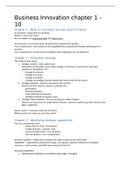Samenvatting
Fundamentals of Business Innovation - FULL course summary - Entrepreneurship & business innovation - Tilburg University
- Instelling
- Tilburg University (UVT)
This summary covers all the content that is covered in the course: Fundamentals of Business Innovation. This course is part of the Bachelor: Entrepreneurship and Business Innovation, at Tilburg University. Year 1, semester 1 COMPLETE SUMMARY
[Meer zien]





